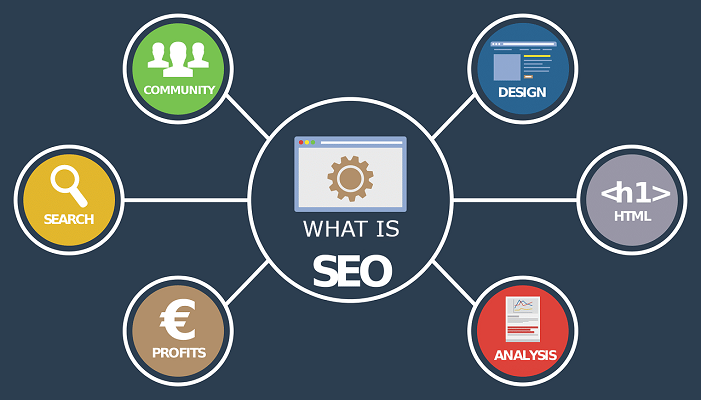Unlock the Secrets to Search Engine Optimization (SEO)

When you search for something online, do you ever wonder how certain websites appear at the top? That’s thanks to Search Engine Optimization (SEO). If you want your website to be noticed by Google and rank higher in search results, then this guide is for you.
We’ll explain SEO, why it matters, and how you can use simple techniques to improve your website’s visibility. By the end of this article, you’ll know exactly how to get started with SEO.
What is SEO?

SEO stands for Search Engine Optimization. It’s all about improving your website to help it show up in search engine results, like Google. When your website is optimized, it has a better chance of appearing higher on the results page. Higher rankings mean more people will visit your site, which is important if you want to grow your online presence.
Why does SEO matter? Because it helps your website get noticed without you needing to pay for ads. Imagine if you had a store, but no one could find it. SEO helps you make your website more visible and easier for people to discover.
Search engines, like Google, use special rules or “algorithms” to decide which websites to show. SEO works by following these rules and making sure your website meets the guidelines. That way, search engines can find and understand your content, helping you reach more people. The better you understand these rules, the more control you have over how your website is presented to users.
Key Parts of SEO
SEO is made up of three key parts: On-Page SEO, Off-Page SEO, and Technical SEO. Let’s explore each one in detail to understand how they help you rank higher in search results.
1. On-Page SEO: Make Your Content Stand Out
On-page SEO is all about the content on your website. This includes things like keywords, content quality, and user experience. By making your website content the best it can be, you increase your chances of ranking higher on search engines. Let’s take a closer look at the main factors of on-page SEO.
Keywords and How to Use Them
Keywords are the words or phrases that people type into search engines. For example, if you have a blog about dogs, your keyword might be “dog care tips.” When Google sees your website contains these keywords, it can match your site with people searching for those topics. But you must use these keywords carefully.
It’s tempting to repeat the same keyword over and over, but that can hurt your SEO. Google can penalize sites for “keyword stuffing,” where a site uses the same keywords too often. Instead, focus on using your keywords in a way that feels natural to readers. This includes placing keywords in titles, headings, and throughout your content, but it’s important to do so without making the text feel forced.
Quality Content: The Heart of SEO
One of the most important aspects of SEO is high-quality content. Google’s algorithms are designed to reward websites that provide valuable, useful, and engaging content. The more informative and well-written your content is, the more likely it is that people will stay on your site longer, which helps your rankings.
Your content should address the needs and questions of your target audience. When you create high-quality, helpful content, people will naturally trust your website and return for more. This also increases the chances of your content being shared, which is another positive signal to Google.
In addition to providing quality information, your content should be easy to read and visually appealing. Break up long paragraphs, use bullet points where appropriate, and ensure your content is structured logically. This will keep visitors engaged and make it easier for them to find the information they need.
User Experience: Make Your Site Easy to Use
Another important factor in on-page SEO is user experience (UX). If your website is difficult to navigate or doesn’t load quickly, people will leave, and that can harm your SEO ranking. Google considers the user experience when ranking sites, so it’s essential to provide a smooth, seamless experience for your visitors.
Your website should be easy to use, intuitive, and mobile-friendly. Make sure your navigation is simple, your design is clean, and your content is organized in a way that makes sense. Additionally, the faster your website loads, the better. People expect fast-loading pages, and if yours takes too long, they may leave before even viewing your content.
2. Off-Page SEO: Build Your Reputation
Off-page SEO refers to all the factors outside of your website that help improve your search engine ranking. While on-page SEO focuses on your content and website structure, off-page SEO focuses on building your website’s reputation and authority. This is mainly achieved through backlinks and social media activity.
Backlinks: Get Other Sites to Link to You
Backlinks are links from other websites to yours. When reputable sites link to your website, it signals to Google that your content is valuable and trustworthy. The more high-quality backlinks you have, the better your SEO performance will be. But not all backlinks are created equal—links from authoritative, relevant websites are much more beneficial than links from low-quality sites.
One of the best ways to build backlinks is by creating shareable content that other websites and blogs will want to link to. You can also guest post on other blogs, collaborate with influencers in your industry, or participate in online communities where your content can be shared.
Backlinks are a long-term strategy, but over time, they can have a significant impact on your rankings. It’s important to focus on building relationships with other trusted websites and creating content that naturally attracts links.
Social Media: Increase Your Reach
While social media doesn’t directly affect search rankings, it plays an important role in off-page SEO. Sharing your content on social media platforms can help increase traffic to your website. The more people visit and share your site, the more likely it is that you’ll get backlinks and other forms of recognition.
To maximize your social media efforts, share your blog posts, engage with followers, and encourage others to share your content. This increases your content’s exposure and provides more opportunities for your site to be linked to by other websites.
3. Technical SEO: Optimize Your Website’s Foundation
Technical SEO is the foundation of your website’s optimization. It ensures that search engines can crawl, index, and understand your site’s content. Without technical SEO, your website may have trouble ranking, even if you have the best content and backlinks.
Site Speed: Don’t Keep Visitors Waiting
Site speed is a major factor in both user experience and SEO. Google prioritizes websites that load quickly because slow sites frustrate users. If your website takes too long to load, people are likely to leave before your content appears, which can hurt your ranking.
To improve site speed, you can compress images, reduce the use of large scripts, and minimize unnecessary files. Tools like Google’s PageSpeed Insights can provide you with specific recommendations on how to speed up your site. Regularly check your site’s performance to ensure it remains fast and efficient.
Mobile-Friendly Design: Optimize for Phones
More and more people browse the web using mobile devices, so it’s essential that your website is mobile-friendly. Google uses mobile-first indexing, meaning it looks at your mobile site before your desktop site when determining rankings. If your site isn’t mobile-friendly, it could hurt your SEO and lead to a poor user experience for visitors on smartphones or tablets.
Ensure that your website design is responsive, meaning it automatically adjusts to different screen sizes. Test your site on various devices to make sure it looks great and functions properly on all of them.
SSL Certificate: Secure Your Site
An SSL certificate makes your website more secure by encrypting the data exchanged between your visitors and your site. Websites with SSL certificates show a padlock icon in the URL bar, signaling that the site is secure. Google gives preference to websites that are secured with SSL, so it’s important to have one for your site.
Most hosting providers offer free SSL certificates, so it’s easy to add this layer of security. Not only does it improve your SEO, but it also reassures visitors that their information is safe when browsing your site.
Why SEO Takes Time

SEO is a long-term strategy. Unlike paid ads, which bring instant traffic, SEO takes time to show results. It can take weeks or even months before you start seeing significant improvements in your rankings. However, the long-term benefits are worth the wait.
Once you start ranking for key keywords, your site will continue to attract visitors without paying for ads. SEO doesn’t have an expiration date, which means the benefits can last for a long time.
Conclusion
SEO might seem complicated at first, but anyone can learn the basics and start applying them to their website. Whether you run a business, a blog, or a personal site, SEO is a great way to increase your visibility and grow your online presence. Start implementing these simple strategies today, and watch your site’s traffic and rankings improve over time.
Frequently Asked Questions (FAQs)
1. How long does it take to see SEO results?
SEO typically takes a few weeks to a few months to show results. This depends on several factors, including how well your site is optimized and the competition for your keywords.
2. What are the best SEO tools to use?
Some of the best SEO tools include Google Analytics, SEMrush, Ahrefs, and Google Search Console. These tools help you track your performance and identify areas to improve.
3. Is SEO important for small businesses?
Yes! SEO is crucial for small businesses because it allows them to compete with larger companies without spending money on ads. It’s a cost-effective way to increase visibility.
4. Can I do SEO on my own?
Yes! Many small business owners manage their own SEO by learning the basics and staying up-to-date on the latest trends.
5. How can local businesses use SEO?
Local SEO helps businesses rank for location-based searches. Optimize your site by including location-specific keywords and setting up a Google My Business profile to increase local visibility.





